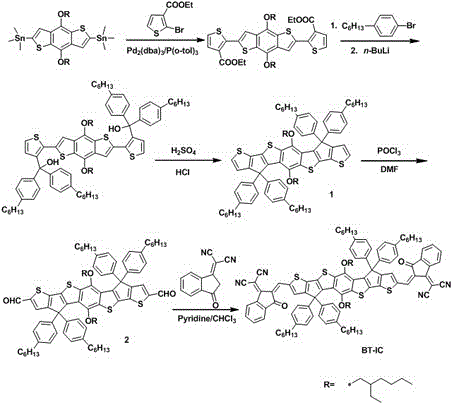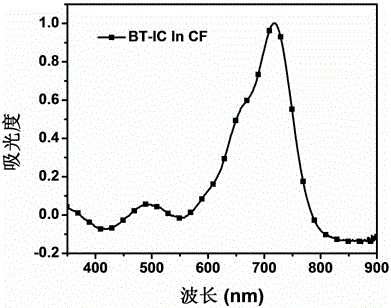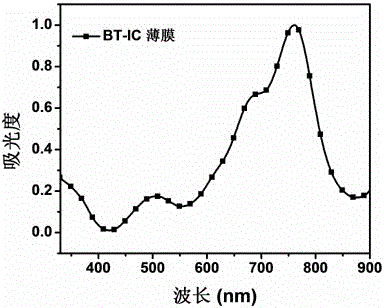Non-fullerene solar energy cell acceptor material based on multiple condensed rings, preparation method and application thereof
A technology for solar cells and acceptor materials, applied in the field of non-fullerene solar cell acceptor materials and their preparation, can solve problems such as insufficient and effective use of sunlight, weak absorption in the visible region, and difficulty in energy level regulation. Achieve the effect of improving photoelectric conversion efficiency, increasing charge mobility, and easy energy level
- Summary
- Abstract
- Description
- Claims
- Application Information
AI Technical Summary
Problems solved by technology
Method used
Image
Examples
Embodiment 1
[0030] when X is Y is A is , the preparation steps of the acceptor material BT-IC are as follows:
[0031] (1) Synthesis of Compound 1: In a 150mL round-bottomed flask, add 2mol of p-hexylbromobenzene and 100mL of tetrahydrofuran under the protection of argon, cool the mixed solution to -78°C, and then add 2mol of n-butyllithium dropwise to it , after the dropwise addition, stirred at -78°C for 60min, then 0.3mol 2,2'-(4,8-bis(alkoxy)benzo[1,2-b:4,5-b'] Dithiophene-2,6-)bis(thiophene-3-ethyl carboxylate) was dissolved in 100mL tetrahydrofuran and added dropwise to the above-mentioned round bottom flask. Extract with dichloromethane, wash with water, dry with anhydrous sodium sulfate, spin dry the solvent, then dissolve in 200mL of acetic acid solution, reflux for 30min, then add 1mL of concentrated sulfuric acid dropwise, reflux for 12h, then cool to room temperature, pour into ice In water, a yellow solid was obtained by suction filtration, extracted with dichlorometha...
PUM
 Login to View More
Login to View More Abstract
Description
Claims
Application Information
 Login to View More
Login to View More - R&D
- Intellectual Property
- Life Sciences
- Materials
- Tech Scout
- Unparalleled Data Quality
- Higher Quality Content
- 60% Fewer Hallucinations
Browse by: Latest US Patents, China's latest patents, Technical Efficacy Thesaurus, Application Domain, Technology Topic, Popular Technical Reports.
© 2025 PatSnap. All rights reserved.Legal|Privacy policy|Modern Slavery Act Transparency Statement|Sitemap|About US| Contact US: help@patsnap.com



